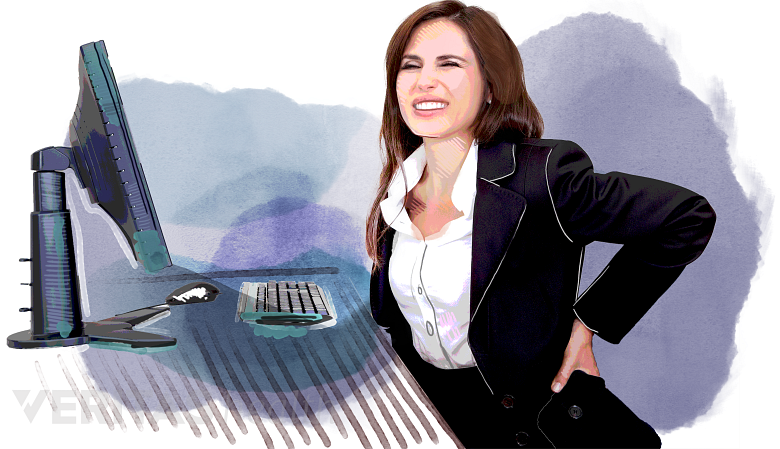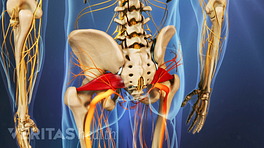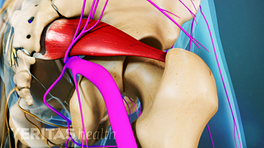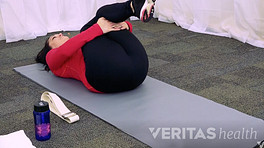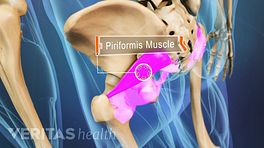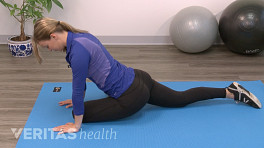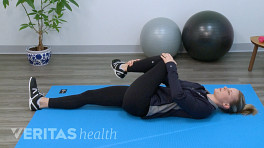The dull and achy or throbbing and searing buttock pain from piriformis syndrome may be calmed with specific types of massages that target the deep buttock muscles. Massage therapy for piriformis muscle pain may also reduce hip and thigh pain that radiates through the sciatic nerve.
In This Blog:
This blog provides a guide to the different types of self-massage techniques to relieve buttock pain at home and specialized techniques used by licensed therapists.
Piriformis syndrome pain is usually felt in the buttock and hip, with some symptoms radiaitng into the thigh and leg.
Self-massage for buttock pain: Relieving buttock muscle pain at home
Self-massage techniques that can be performed at home to help relieve pain caused by piriformis syndrome include:
Foam rolling
Foam rolling is a form of myofascial release where you use a foam roller to apply pressure to specific areas of your body to release muscle tightness and reduce pain.
To use a foam roller for piriformis muscle pain:
- Lie on your back.
- Tighten your core muscles and lift up into a slight bridge.
- Place the foam roller under your buttock.
- Roll up and down between your buttock and lower back, focusing more on the tight or painful areas.
Continue for 30 seconds to a minute.
A smooth foam roller provides a gentler massage and a foam roller with a textured surface can help provide a deeper massage and reach the painful trigger points easily.
Tennis ball massage
A tennis ball provides a pinpointed massage and allows you to put more focused pressure on the painful area. Tennis ball massages can help relieve tension in tight muscles and increase blood flow.
To perform a tennis ball massage:
- Sit on a chair with the tennis ball placed directly under the buttock.
- Lean into the ball, shifting your weight, and applying pressure on the buttock muscles.
- If you find a tender spot, keep sustained pressure on the area for a longer time.
- Hold for 30 seconds to a minute.
If a tennis ball is not available, a lacrosse ball or a small medium-firm ball will work for this massage.
Both tennis ball and foam roller massages may cause slight discomfort when the trigger points are massaged. This pain should be tolerable and if intolerable to severe pain is experienced, the massage should be stopped immediately. Pain experienced during a massage (whether at home or by a therapist) should always be within tolerable limits.
Ice massage
Ice massage is a simple and effective way to relieve acute buttock pain caused by piriformis syndrome. The cold temperature of the ice helps reduce inflammation and numb the pain.
To perform an ice massage:
- Make an ice massage applicator at home using these steps: How to Make an Ice Massage Applicator
- Lie on your back and extend the leg on the painful side.
- Place the ice massage applicator directly on the buttock.
- Apply mild pressure to the applicator and massage the area in a circular motion.
- Limit the ice massage therapy to about 5 minutes at a time (to avoid an ice burn).
Remove the ice pack and let the area return to its normal temperature. Repeat the ice massage two to five times a day with at least 20 to 30 minutes of rest between applications.
Ice application should be avoided by patients with certain medical conditions, such as patients who have rheumatoid arthritis, Raynaud’s Syndrome, or areas of impaired sensation.
Thai massage: Combining the benefits of yoga and massage
Thai massage combines the benefits of gentle yoga stretching with massage strokes. The massage is delivered along specific energy or "sen" lines of the body. 1 Stone VJ. The World’s Best Massage Techniques: The Complete Illustrated Guide ; Innovative Bodywork Practices from around the Globe for Pleasure, Relaxation, and Pain Relief. Fair Winds Press; 2010. In Thai massage, the patient performs passive yoga stretches, while the therapist massages specific areas of the body to relieve stress.
Yoga massage can help strengthen and stabilize your core muscles, increase flexibility in your hip and spine, and reduce lower back pain and buttock pain. 2 Fishman L. Healing Yoga: Proven Postures to Treat Twenty Common Ailments – from Backache to Bone Loss, Should Pain to Bunions, and More. W.W. Norton & Company; 2015. Thai yoga massage also eases muscle stiffness through assisted yoga stretches to make muscles more flexible and promote improved blood circulation.
Neuromuscular therapy: A technique to release a tight piriformis muscle
Neuromuscular massage therapy (NMT), also called myofascial trigger point therapy, is a therapeutic massage that works on the principle of applying sustained pressure using the thumb for 30 seconds to 2 minutes on a muscle’s ‘trigger points’ to alleviate pain and tension. 3 Shah JP, Thaker N, Heimur J, Aredo JV, Sikdar S, Gerber L. Myofascial Trigger Points Then and Now: A Historical and Scientific Perspective. PM R. 2015.7(7):746-761. http://doi.org/j.pmrj.2015.01.024
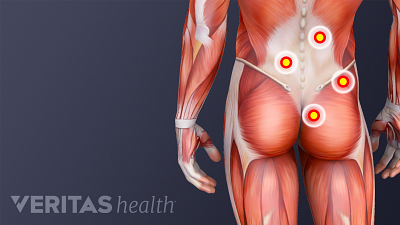
Neuromuscular massage therapy involves applying sustained pressure on a muscle's 'trigger points' to alleviate pain and tension.
Neuromuscular therapy to release a tight piriformis muscle involves applying pressure to trigger points in the center of the buttock. A physical therapist or massage therapist trained in NMT can accurately identify muscle trigger points.
When the sustained pressure is released, the muscle fibers are loosened, blood flow is stimulated into the area, and patients tend to feel immediate pain relief. Neuromuscular therapy may also lead to a greater range of motion in the joints from relaxed muscle tissues.
How massage helps relieve buttock pain from piriformis syndrome
Massage helps ease the symptoms of tight and sore muscles through the following changes in the body:
- Loosen and relax muscles. When the piriformis muscles are tight, they can spasm and compress the sciatic nerve. Massage therapy can stretch, loosen, and elongate tight muscles, improving the pain and function in your buttock, hip, and leg on the affected side. 1 Stone VJ. The World’s Best Massage Techniques: The Complete Illustrated Guide ; Innovative Bodywork Practices from around the Globe for Pleasure, Relaxation, and Pain Relief. Fair Winds Press; 2010.
- Facilitate the circulation of healing nutrients. Hands-on soft tissue manipulation from massage stimulates the blood vessels in your skin and deeper tissues. There is increased circulation of blood, oxygen, and other nutrients to the sore area, promoting healing. 1 Stone VJ. The World’s Best Massage Techniques: The Complete Illustrated Guide ; Innovative Bodywork Practices from around the Globe for Pleasure, Relaxation, and Pain Relief. Fair Winds Press; 2010.
- Release endorphins. Massage stimulates specific pressure receptors in your brain, which are special nerve fibers. Stimulating these pressure receptors helps reduce pain by releasing endorphins, the body’s natural feel-good hormone. 1 Stone VJ. The World’s Best Massage Techniques: The Complete Illustrated Guide ; Innovative Bodywork Practices from around the Globe for Pleasure, Relaxation, and Pain Relief. Fair Winds Press; 2010.
It is essential to use proper techniques when performing self-massage, as improper techniques may cause more harm and further injure the affected area. Self-massage techniques are generally safe but should be stopped immediately if you experience any signs of worsening pain.
Massage therapy may be more effective when combined with other standard back pain treatments, such as pain-relieving medications, guided physical therapy, and a daily routine of stretching and exercise.
Before starting any new treatment for piriformis syndrome, it is advisable to speak with a physician or physical therapist. Treatment options generally vary based on the individual’s underlying condition and the severity of the symptoms, so a personalized treatment plan can help deliver better results.
Learn more:
- 1 Stone VJ. The World’s Best Massage Techniques: The Complete Illustrated Guide ; Innovative Bodywork Practices from around the Globe for Pleasure, Relaxation, and Pain Relief. Fair Winds Press; 2010.
- 2 Fishman L. Healing Yoga: Proven Postures to Treat Twenty Common Ailments – from Backache to Bone Loss, Should Pain to Bunions, and More. W.W. Norton & Company; 2015.
- 3 Shah JP, Thaker N, Heimur J, Aredo JV, Sikdar S, Gerber L. Myofascial Trigger Points Then and Now: A Historical and Scientific Perspective. PM R. 2015.7(7):746-761. http://doi.org/j.pmrj.2015.01.024

